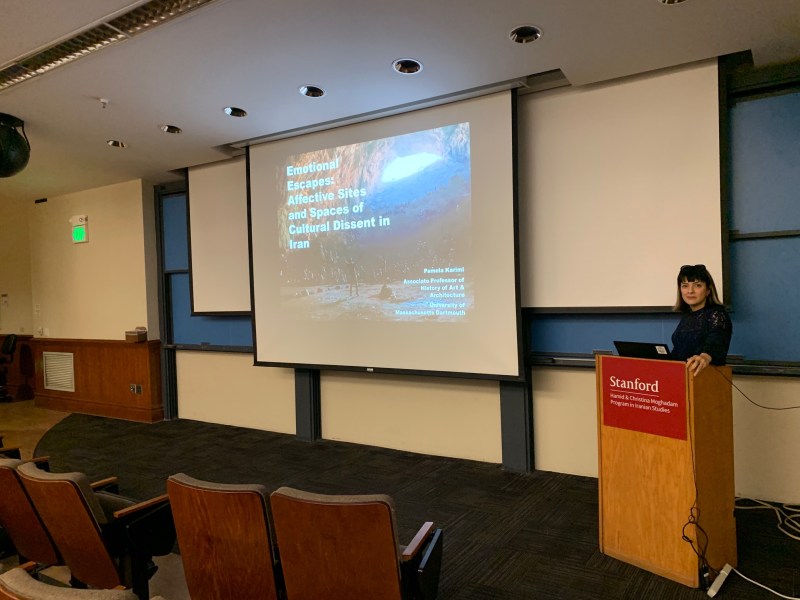“When certain objects produce a certain set of effects in a given context for a group of people, that is the structure of feeling,” art history scholar Pamela Karimi told her audience Thursday night. “And sometimes the structures of feeling are personal and idiosyncratic — but more often they occur across generations.”
A history of art and architecture associate professor at the University of Massachusetts, Dartmouth, Karimi’s talk was titled “Emotional Escapes: Affective Sites and Spaces of Cultural Dissent in Iran” and was sponsored by the Hamid and Christina Moghadam Program in Iranian Studies and the Art, Social Space and Public Discourse initiative. The research she presented was focused on dissent against government in Tehran, Iran and the pursuit of creativity that followed, through both covert and public practice. Her talk drew on the work of scholars Raymond Williams, Jonathan Flatley, Sarah Ahmed and Anna Gibbs.
Structures of feeling, Karimi said, are manifested in Iranian art galleries that were originally bomb shelters. Iranian artists, often censored by the press, expressed their trauma and loneliness through art in these underground galleries and apartments.
Through a visual slideshow presentation of Iranian art, photography and theatrical performance, Karimi highlighted the various ways humans travel through space.
“The affective lives of subversive spaces are entangled in not only the human rational choices… but also the analytic powers entrenched in shame, unhappiness, fear, loss and trauma,” Karimi said.
After providing a brief history of various defiant spaces in Iran, Karimi led the audience through different kinds of concealed spaces and the resistance to authority that can occur within them.
“Resistance in private spaces is often overlooked,” Karimi said, referencing a displayed picture of a kitchen, an example of a space in which Iranians could openly discuss their problems with the authorities.
In the 1980s, artists experienced significant censorship from the media, she said. The Iranian artistic revolution originated in people’s homes and even in salons, Karimi said. Such performance of normally public activities in private homes exemplified an “alignment of bodily and social space.”
Through the nonverbal and bodily movement, Iranians participated in theatrical performances even though they were not students of theatre. Often, such individuals had studied architecture but were interested in utilizing space through physical human interaction, according to Karimi. Nyia, a semi-professional arts group, is one such example of the subversive, underground arts scene in Iran that allows individuals to utilize architecture for personal expression.
Tying creative dissent in Iran to the current digital age, Karimi acknowledged the role of social media in the arts scene. She stated that the actions of liking and tagging on social media foster individual expression.
“We [in the U.S.] tend to sensationalize Iranian underground art,” Karimi concluded. [Social media and data capture] are the sites where human emotion such as compulsion, anxiety and joy are materialized.”
This article has been corrected to reflect that Karimi said that artists in Iran experienced significant censorship in the 1980s, not 1990s. The Daily regrets this error. It has also been updated to indicate that Karimi’s talk drew on the work of other scholars.
Contact Yusra Arub at yusraarub19 ‘at’ mittymonarch.com.
